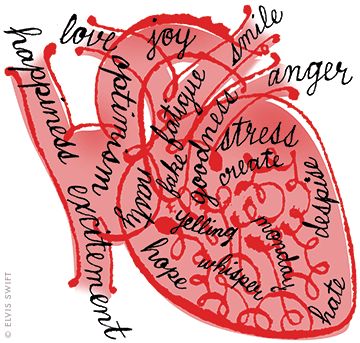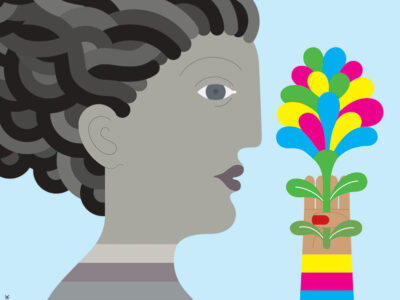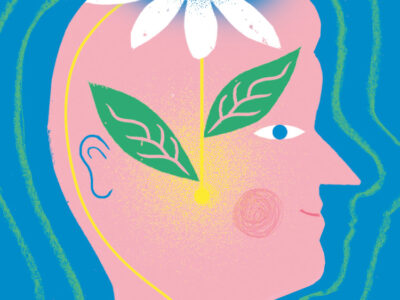
Johannes Eichstaedt LPS’11 was conjuring up a familiar image: of people sitting around a campfire, telling stories and popping off about their lives. But it didn’t take long to realize that he wasn’t talking about your grandfather’s campfire, and that the implications of the collected stories went well beyond fishing, gossip, and burnt s’mores.
“I can listen in to thousands of digital campfires and get tweets from a lot of people,” said Eichstaedt, a doctoral candidate in psychology, during a recent presentation for the Penn Science Café series at World Café Live. “And then I can say that on the whole, for somebody in this cluster, the risk for heart disease is higher.”
Eichstaedt was pointing to one of the “word clouds” filled with the most frequently used words culled from some 148 million tweets (anonymized but individually mapped to users’ home counties), which he and his colleagues in a Penn-dominated team of researchers had broken down into categories like hostility/aggression, hate/interpersonal tension, and boredom/fatigue. The team had just published an article titled “Psychological Language on Twitter Predicts County-Level Heart Disease Mortality” in Psychological Science, reporting that their model predicted the mortality from a bellwether heart disease (atherosclerotic heart disease, or AHD), “significantly better than did a model that combined 10 common demographic, socioeconomic, and health risk factors.” Among the authors were Martin Seligman Gr’67, the Zellerbach Family Professor of Psychology and director of the Positive Psychology Center; and Lyle Ungar, professor of computer and information science.
“We can cover our eyes, and—for the parts of the country that our models have never seen—just look at their Twitter [output], and we can estimate their heart disease based on the language they use,” Eichstaedt said. The results, he added, come “surprisingly close” to CDC data.
“These methods can’t tell you who will die from heart disease,” he emphasized. “They can only tell you that for a community as a whole, it has these properties that will make people who are at risk for heart disease more susceptible to die [of it]. This is something eco-epidemiologists have been telling us for a long time—the neighborhoods you’re in matter.”
Cardiovascular disease is the leading cause of death in the US, Eichstaedt noted, and multiple studies have concluded that AHD is directly affected by anger and stress. The study found that “greater usage of anger, negative-relationship, negative-emotion, and disengagement words was significantly correlated with greater age-adjusted AHD mortality.”
The “single most predictive word for a community to have high rates of AHD is hate,” said Eichstaedt. Yet elevated rates of AHD could also be tied to less-aggressive language, such as words like bored, tired, and bed.
Some emotive words were associated with lower rates of AHD. They fell into categories the researchers labeled skilled occupations, positive experiences, and optimism. Many of these suggest high levels of education and creative employment.
“It’s actually more important what the education of your neighbors is than what your own education is, for your overall satisfaction of life,” since well-educated communities usually provide parks, concerts, playgrounds, and places to walk and exercise, contended Eichstaedt, who is a founding research scientist of Penn’s World Well-Being Project.
As in many correlation studies, the team had to reckon with a lot of potentially confounding variables. One was that different populations use Twitter in different ways. Urban populations in poor areas “use Twitter the way you or I might use email,” said Eichstaedt. “So relational concerns, boyfriend-girlfriend relationships, things that you and I might text or email about, they discuss on Twitter.” As a result, the use of Twitter words like boyfriend, girlfriend, relationship, and even love becomes “a marker of areas of the country where income and education is really, really low.”
Nevertheless, the team’s findings “align with a growing body of research supporting the cardiovascular health benefits of psychological well-being,” the strongest being “engagement,” the study noted. Around the time of Eichstaedt’s January talk, a new regression analysis of data from the Multi-Ethnic Study of Atherosclerosis found a positive association between optimism and cardiovascular health.
“We’ve found over many years that the things that determine both life satisfaction and heart disease now are forms of engagement and disengagement,” Eichstaedt explained. “Basically being excited, living an interesting life, having a reason to get out of bed in the morning.”—S.H.




